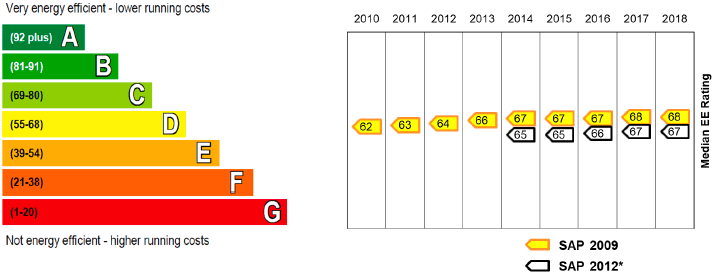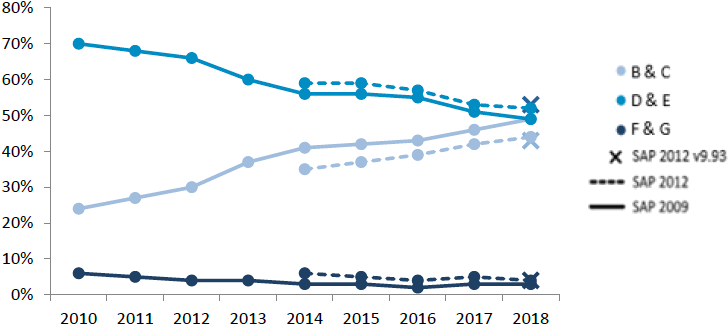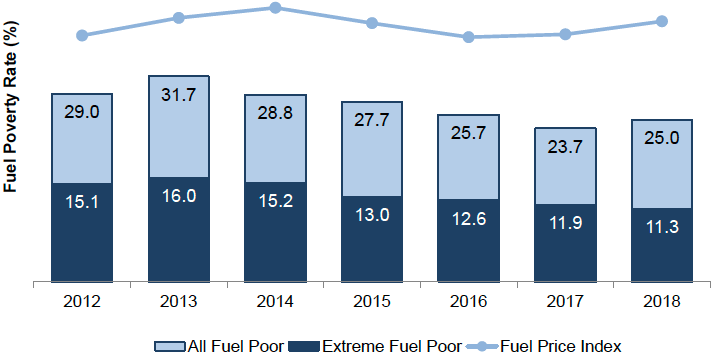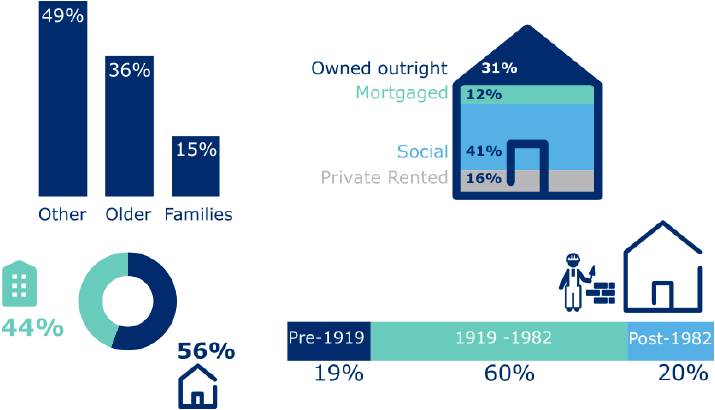Scottish house condition survey: 2018 key findings
Figures from the 2018 survey, including updated fuel poverty rates, energy efficiency ratings, the condition of housing and the Scottish Housing Quality Standard.
Key Findings Summary
Energy Efficiency and Carbon Emissions
- In 2018, 43% of Scottish homes were rated as EPC band C or better and half had an energy efficiency rating of 67 or higher (SAP 2012 (RdSAP v9.93) ).
Median Energy Efficiency Rating Relative to EPC Band, SAP 2009 and SAP 2012*, 2010 to 2018

SAP 2012 (RdSAP v9.92) for 2014-2017 and SAP 2012 (RdSAP v9.93) for 2018.
- Using SAP 2009 continues to show long-term improvement in the energy efficiency profile of housing. The share of the most energy efficient dwellings (rated C or better) increased from 24% in 2010 to 49% in 2018. In the same period, the proportion of properties in the lowest EPC bands (E, F or G) more than halved, reducing from 27% to 12%.
Proportion of Scottish Homes by Grouped EPC Band, SAP 2009, SAP 2012 (RdSAP v9.92) and SAP 2012 (RdSAP v9.93), 2010-2018

- The share of homes with lofts insulated to 100 mm or more remained at 94% in 2018. This represents an increase of 12 percentage points on 2010 levels. 30% of lofts were insulated to a high standard of insulation (300 mm or more), a similar level to 2015-2017 following significant increases from 5% in 2010.
- Wall insulation measures continue to be delivered under energy efficiency programmes such as the Energy Company Obligation (ECO)[1]. Levels of wall insulation remained similar in the last year, with 59% of walls having insulation in 2018. However, there is a longer term trend of improvement with 19% of solid wall dwellings and 73% of cavity wall dwellings being insulated in 2018, representing an increase from 11% and 66% respectively in 2012.
- In 2018, 62% of gas and oil boilers met the minimum efficiencies specified by current Building Standards, an increase of 5 percentage points from 2017.
- 33% of dwellings had an Environmental Impact Rating in band C or better in 2018 (SAP 2012 (RdSAP v9.93)). The mean rating was 61 and the median was 63, both of which lie in band D.
- Based on modelled energy use, the average Scottish home is estimated to produce 6.8 tonnes of CO2 per year. Average modelled carbon emissions for all properties have continued to decrease to 73 kg/m2 in 2018 compared to 80 kg/m2 in 2014.
Fuel Poverty and Heating Satisfaction
- In July 2019 the Fuel Poverty (Targets, Definition and Strategy) (Scotland) Act[2] received Royal Assent. This Act contains a new definition of fuel poverty which affects how fuel poverty is to be defined and measured. The figures presented in this report are a best estimate of fuel poverty and extreme fuel poverty rates under the proposed new definition of fuel poverty, following amendments agreed at Stage 2 of the Fuel Poverty (Targets, Definition and Strategy) Bill.
- The first set of fuel poverty estimates fully compatible with all of the elements of the new definition in the Fuel Poverty (Targets, Definition and Strategy) (Scotland) Act are expected to be published in December 2021. This requires additional information being collected in the 2020 Scottish House Condition Survey and the production of a new Minimum Income Standard (MIS) for Remote Rural, Remote Small Town and Island areas, which, for the Stage 2 estimates contained in this publication, has been estimated based on previous studies.
- In 2018, 25.0% of households (619,000) were estimated to be in fuel poverty, a similar level to 2017 (23.7% or 583,000 households). 11.3% (or 279,000 households) were living in extreme fuel poverty in 2018. This follows a period of annual decreases since 2013 and is the lowest rate recorded by the survey since 2012, the first year of data available under the new definition.
- The actual median fuel poverty gap for fuel poor households in 2018 was similar to 2017 (£650 and £690, respectively). The median fuel poverty gap (adjusted for 2015 prices) for fuel poor households in 2018 (£610) has decreased from £710 in 2012.
Proportion of Households in Fuel Poverty and Extreme Fuel Poverty, 2012-2018

Note: Energy requirement underpinning fuel poverty estimate modelled on the following basis: 2012 – 2013: BREDEM 2012 v.1.0; from 2014 onwards: BREDEM 2012 v.1.1, and New Prices to the adjustment of fuel price sources from 2013. From 2016 a further improvement is included by assigning pre-payment metered fuel prices to the relevant households.
Note: This is the first time the 2012-2015 estimates have been published and the estimates are not comparable to those in previous Key Findings reports. See Section 4.1 for more details.
- The 2018 fuel poverty rate is likely to reflect changes in fuel prices, income and energy efficiency.
- Households using gas as their primary heating fuel had a similar fuel poverty rate in 2018 as in 2017. Consequently, fuel poverty rates for households living in urban areas were similar to that in 2017 (25% versus 23%), although larger urban areas saw an increase in fuel poverty from 21% in 2017 to 25% in 2018.
- Rates of fuel poverty differed between the social (39%) and private sector (20%) in 2018. These are similar rates to those in 2017 although households who owned outright saw an increase in fuel poverty rates with 23% estimated to be in fuel poverty compared to 18% in 2017.
- Fuel poverty has a strong association with income and households in the lower income bands have the highest rates of fuel poverty: 95% for the bottom income band and 55% for the 2nd bottom band. Fuel poverty rates across all income bands are similar to 2017 fuel poverty rates.
- Around half (49%) of fuel poor households are adults without children (other) households. Around 15% of households living in fuel poverty are families with children, and 36% are older households. 43% of fuel poor households are owner occupiers, 41% are social housing residents and the remaining 16% rent in the private sector.
Composition of Fuel Poor Households, 2018

- As in 2017, overall rates of extreme fuel poverty were similar between the social (13%) and private sector (10%) in 2018, although levels of extreme fuel poverty in housing association households have decreased from 18% in 2017 to 11% in 2018.
- Levels of extreme fuel poverty were higher in rural areas (17%) compared to urban areas (10%) in 2018.
- Households in the lower income bands have the highest rates of extreme fuel poverty: 68% for the bottom income band (<£200 a week) dropping to no cases in the highest income band (£700+ a week). Extreme fuel poverty rates in the second lowest income band (£200-£299.99 a week) have dropped in 2018 (16%) compared to 2017 (22%).
- Fuel poor and extreme fuel poor households are more likely to report difficulties staying warm in winter. 29% of fuel poor and 32% of extreme fuel poor say that their heating keeps them warm in winter “only sometimes” or “never” compared to 15% of all other households. 8% of fuel poor and 11% of extreme fuel poor households report that they cannot afford to heat their home, higher than the 3% of non-fuel poor households.
- Overall, there has been no change in the past year in the share of all householders reporting that their heating only sometimes (14%) or never (4%) keeps them warm in winter.
- The extent to which home energy use is monitored by householders has increased since last year with 58% stating they monitor their energy use “very” or “fairly closely”. 28% of households report owning an energy monitoring device – a 9 percentage point increase on 2017.
- Fuel poor and extreme fuel poor households are more likely to monitor their energy use than other households (62% and 65% respectively compared to 57% for non-fuel poor households) but they are less likely to own a monitoring device (23% for both compared to 29% for non-fuel poor households).
Housing Conditions
- The level of disrepair increased by 7 percentage points from last year, with 75% of all dwellings having some degree of disrepair, however minor it may be in 2018. Disrepair to critical elements stood at 57%, an increase of 7 percentage points since 2017.
- 30% of dwellings had some instances of urgent disrepair, and in 6% of the housing stock some extensive disrepair was present. Neither of these represent a statistically significant difference from 2017 although there is a longer-term trend of improvement since 2012.
- Levels of damp and condensation were similar to that seen in 2017: 89% of properties were free from any damp or condensation.
- Levels of compliance with the tolerable standard in 2018 decreased slightly from 2017, returning to 2016 levels: 2% (or 50,000) of all dwellings fell below the Tolerable Standard in 2018. Longer term this represents an improvement of 2 percentage points since 2012.
- In 2018, 41% of Scottish homes failed to meet the Scottish Housing Quality Standard (SHQS), similar to 2017 levels but down from 45% in 2016 and 61% in 2010. The majority of dwellings falling below the SHQS failed on a single criterion: this accounts for almost 8 out of 10 failures.
- The SHQS failure rate in the social sector was 36%, not allowing for abeyances and exemptions. This has fallen from 60% in 2010. 26% of social sector properties did not meet the Energy Efficient criterion. The majority of social sector dwellings falling below the SHQS failed on a single criterion: this accounts for more than 8 out of 10 failures.
- SHCS surveyors may not always be able to identify the presence of cavity wall insulation. The overall SHQS failure rate in the social sector would be 23% if it is assumed that all social dwellings have insulated cavity walls where this is technically feasible.
- For almost three quarters of social homes failing the SHQS this was due to falling short on a single one of the 55 elements which make up the standard. Most frequently these were cavity wall insulation, pipe and tank insulation, full and efficient central heating, effective loft insulation, at least six kitchen sockets, and safe common front and rear doors.
- Overcrowding levels in Scotland remain unchanged: 2% of all households (53,000) were living in overcrowded accommodation in 2018. Social sector dwellings (4%) were more likely to be overcrowded than private sector
dwellings (1%).
Contact
There is a problem
Thanks for your feedback